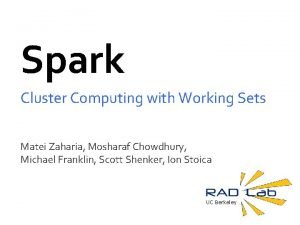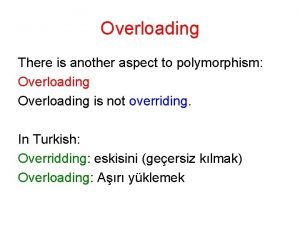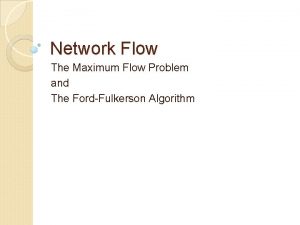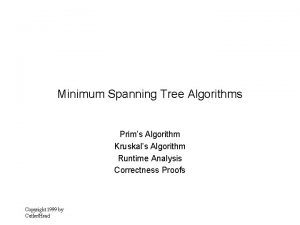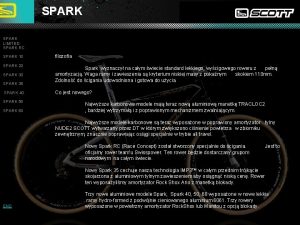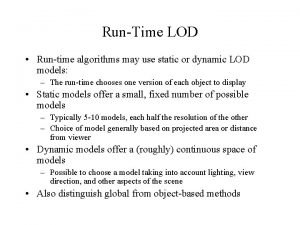1 SPARK CLUSTER SETTING Why Use Spark Runtime
















![Basic Transformations > nums = sc. parallelize([1, 2, 3]) # Pass each element through Basic Transformations > nums = sc. parallelize([1, 2, 3]) # Pass each element through](https://slidetodoc.com/presentation_image_h/bfcff353206ca22107a604270129c599/image-17.jpg)
![Basic Actions > nums = sc. parallelize([1, 2, 3]) # Retrieve RDD contents as Basic Actions > nums = sc. parallelize([1, 2, 3]) # Retrieve RDD contents as](https://slidetodoc.com/presentation_image_h/bfcff353206ca22107a604270129c599/image-18.jpg)





- Slides: 23

1 SPARK CLUSTER SETTING 賴家民

Why Use Spark Runtime Architecture Build Spark Local mode Standalone Cluster Manager Hadoop Yarn Spark. Context with RDD 2

Why Use Spark Speed Ease of Use Generality Runs Everywhere

Spark Runtime Architecture The Driver 1. Converting a user program into tasks 2. Scheduling tasks on executors Executor worker processes responsible for running the individual tasks 4

Spark Runtime Architecture in this course Spark Driver scml 1 Cluster Master Standalone Cluster Worker Executor scml 1 Executor scml 2

Build Spark - Download it first Go to https: //spark. apache. org/downloads. html Chose Spark version with the package fit your system. wget …………………. 6

Build Spark - Start to build Set JAVA_HOME � Vim ~/. bashrc ; � export JAVA_HOME=/usr/lib/jvm/java-7 -oracle Built with the right package � mvn -Dskip. Tests clean package Built in our course � mvn package -Pyarn -Dyarn. version=2. 6. 0 -Phadoop-2. 4 Dhadoop. version=2. 6. 0 -Phive –Dskip. Tests � If you don’t built like this, you will get IPC connection fail. 7

Build Spark – Set SSH certificates ssh-keygen -t rsa -P "" cat $~/. ssh/id_rsa. pub >> $~/. ssh/authorized_keys scp ~/. ssh/authorized_keys scml@scml 2: ~/. ssh Because of setting it when building hadoop, we ignore this step. 8

Local mode Interactive shells � bin/pyspark � bin/spark-shell Launch application � � bin/spark-submit my_script. py If Spark cluster start, bin/spark-submit –master local my_script. py 9

Standalone Cluster Manager scml 1 � cp slaves. template slave � vim ~/spark-1. 2. 0/conf/slaves � ADD scml 1 and scml 2 � cp spark-env. sh. template spark-env. sh � ADD export SPARK_MASTER_IP=192. 168. 56. 111 � ADD export SPARK_LOCAL_IP=192. 168. 56. 111 10

Standalone Cluster Manager scml 2 cp spark-env. sh. template spark-env. sh � ADD export SPARK_MASTER_IP=192. 168. 56. 111 � ADD export SPARK_LOCAL_IP=192. 168. 56. 112 � Check this standalone run or not � spark-1. 2. 0/bin/spark-submit --master spark: //192. 168. 56. 111: 7077 spark_test. py Spark Standalone Web UI � 192. 168. 56. 1: 8080 11

Standalone Cluster Manager Parameter � --executor-memory � --driver-memory � --total-executor-cores � --deploy-mode cluster or client HDFS input � raw. Data = sc. text. File("hdfs: //192. 168. 56. 111: 9000/kddcup. data_1 0_percent") � Depend on your hadoop core-site. xml setting 12

Hadoop Yarn scml 1 � Vim spark-1. 2. 0/conf/spark-env. sh; Add export HADOOP_CONF_DIR="/home/scml/hadoop 2. 6. 0/etc/hadoop/” Check this Yarn Manager run or not � spark-1. 2. 0/bin/spark-submit --master spark: //192. 168. 56. 111: 7077 spark_test. py 13

Spark. Context with RDD Main entry point to Spark functionality Available in shell as variable sc 14

Creating RDDs # Turn a Python collection into an RDD > sc. parallelize([1, 2, 3]) # Load text file from local FS, HDFS, or S 3 > sc. text. File(“file. txt”) > sc. text. File(“directory/*. txt”) > sc. text. File(“hdfs: //namenode: 9000/path/file”) # Use existing Hadoop Input. Format (Java/Scala only) > sc. hadoop. File(key. Class, val. Class, input. Fmt, conf)

Creating RDDs # Turn a Python collection into an RDD > sc. parallelize([1, 2, 3]) # Load text file from local FS, HDFS, or S 3 > sc. text. File(“file. txt”) > sc. text. File(“directory/*. txt”) > sc. text. File(“hdfs: //namenode: 9000/path/file”) # Use existing Hadoop Input. Format (Java/Scala only) > sc. hadoop. File(key. Class, val. Class, input. Fmt, conf)
![Basic Transformations nums sc parallelize1 2 3 Pass each element through Basic Transformations > nums = sc. parallelize([1, 2, 3]) # Pass each element through](https://slidetodoc.com/presentation_image_h/bfcff353206ca22107a604270129c599/image-17.jpg)
Basic Transformations > nums = sc. parallelize([1, 2, 3]) # Pass each element through a function > squares = nums. map(lambda x: x*x) // {1, 4, 9} # Keep elements passing a predicate > even = squares. filter(lambda x: x % 2 == 0) // {4} # Map each element to zero or more others > nums. flat. Map(lambda x: => range(x)) > # => {0, 0, 1, 2} Range object (sequence of numbers 0, 1, …, x-1)
![Basic Actions nums sc parallelize1 2 3 Retrieve RDD contents as Basic Actions > nums = sc. parallelize([1, 2, 3]) # Retrieve RDD contents as](https://slidetodoc.com/presentation_image_h/bfcff353206ca22107a604270129c599/image-18.jpg)
Basic Actions > nums = sc. parallelize([1, 2, 3]) # Retrieve RDD contents as a local collection > nums. collect() # => [1, 2, 3] # Return first K elements > nums. take(2) # => [1, 2] # Count number of elements > nums. count() # => 3 # Merge elements with an associative function > nums. reduce(lambda x, y: x + y) # => 6 # Write elements to a text file > nums. save. As. Text. File(“hdfs: //file. txt”)

Working with Key-Value Pairs Spark’s “distributed reduce” transformations operate on RDDs of key-value pairs Python: pair = (a, b) pair[0] # => a pair[1] # => b Scala: val pair = (a, b) pair. _1 // => a pair. _2 // => b Java: Tuple 2 pair = new Tuple 2(a, b); pair. _1 // => a pair. _2 // => b

Some Key-Value Operations > > pets = sc. parallelize( [(“cat”, 1), (“dog”, 1), (“cat”, 2)]) pets. reduce. By. Key(lambda x, y: x + y) # => {(cat, 3), (dog, 1)} > pets. group. By. Key() # => {(cat, [1, 2]), (dog, [1])} > pets. sort. By. Key() # => {(cat, 1), (cat, 2), (dog, 1)} also automatically implements combiners on the map side reduce. By. Key

Example: Word Count > > lines = sc. text. File(“hdfs: //192. 168. 56. 111: 9000/hamlet. txt”) counts = lines. flat. Map(lambda line: line. split(“ ”)). map(lambda words : (word, 1)). reduce. By. Key(lambda x, y: x + y) “to be or” “to” “be” “or” (to, 1) (be, 1) (or, 1) (be, 2) (not, 1) “not to be” “not” “to” “be” (not, 1) (to, 1) (be, 1) (or, 1) (to, 2)

Other Key-Value Operations > > visits = sc. parallelize([ (“index. html”, “ 1. 2. 3. 4”), (“about. html”, “ 3. 4. 5. 6”), (“index. html”, “ 1. 3. 3. 1”) ]) page. Names = sc. parallelize([ (“index. html”, “Home”), (“about. html”, “About”) ]) visits. join(page. Names) # (“index. html”, (“ 1. 2. 3. 4”, “Home”)) # (“index. html”, (“ 1. 3. 3. 1”, “Home”)) # (“about. html”, (“ 3. 4. 5. 6”, “About”)) visits. cogroup(page. Names) # (“index. html”, ([“ 1. 2. 3. 4”, “ 1. 3. 3. 1”], [“Home”])) # (“about. html”, ([“ 3. 4. 5. 6”], [“About”]))

Thank sena. lai 1982@gmail. com 23
 Spark runtime architecture
Spark runtime architecture Hey hey bye bye
Hey hey bye bye Spark sql: relational data processing in spark
Spark sql: relational data processing in spark Docker spark cluster
Docker spark cluster Spark: cluster computing with working sets
Spark: cluster computing with working sets Dont ask why why why
Dont ask why why why How do new ideas spark change
How do new ideas spark change Key issue 1 why do services cluster downtown
Key issue 1 why do services cluster downtown Why do services cluster downtown?
Why do services cluster downtown? Subdivision of runtime memory
Subdivision of runtime memory What is in system programming
What is in system programming Openplc runtime
Openplc runtime Difference between compile time and runtime
Difference between compile time and runtime Kinect for windows speech recognition language pack
Kinect for windows speech recognition language pack What is a constructor in java
What is a constructor in java Heapify runtime
Heapify runtime Matrix multiplication time complexity
Matrix multiplication time complexity Runtime error index out of bounds
Runtime error index out of bounds Dynamic class loading in java
Dynamic class loading in java Runtime storage management in compiler design
Runtime storage management in compiler design Ford fulkerson runtime
Ford fulkerson runtime Prims algorithm runtime
Prims algorithm runtime Basic runtime checks
Basic runtime checks Run-time error example
Run-time error example




